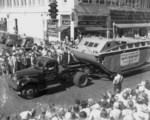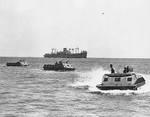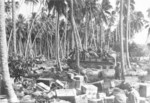Landing Vehicle Tracked
| Country | United States |
| Primary Role | Other |
Contributor: Alan Chanter
ww2dbaseThe Landing Vehicle Tracked (LVT) was an amphibious vehicle used by the United States Navy, Marine Corps and Army during World War II. It was widely known as amphtrack, amtrak, amtrac etc., a portmanteau of amphibious tractor.
ww2dbaseHistory
ww2dbaseIn the assault on Tarawa the LVTs proved their worth by successfully ferrying men across the coral reef and through the shallows to the beach. Marines who arrived in LCVP Higgins boats, on the other hand, could not cross the reef and had to wade through chest-deep or higher water while being raked by Japanese machine guns; casualties were horrific and many who did make it to the beach alive had lost their rifles and other essential gear. Of 125 vehicles used in the assault, only 35 remained operational by the end of the day.
ww2dbaseFor the Rhine crossing on the 23rd March 1945 the 21st Army Group had some 600 Buffalos available and most of these would be used to land the assault infantry. Because the muddy going was expected to hamper the DD tanks, some of these LVTs were armed with a light cannon and two machine guns to act as substitute tanks until bridges could be constructed across the river. The "Specials" of the 79th Armoured (The Black Bull) Division also provided Buffalos fitted with "Bobbin" carpets to create temporary roadways over the mud. The 7th Black Watch and 1st Commando Brigade were among the first troops to make the crossing in Buffalos, and these were soon followed by others carrying more infantry and heavy equipment for the bridgehead.
ww2dbaseVariants
ww2dbaseLanding Vehicle Tracked, Mark 1 (LVT-1)
ww2dbaseThe Landing Vehicle Tracked (LVT) owed its existence to a 1930s project by a retired engineer, Donald Roebling to build an amphibious vehicle that could be used in the Florida Everglades. His finished prototype, which he named Alligator, soon aroused the interest of the US Marine Corps when an article about it appeared in a US magazine. The Marines had been looking for just such a vehicle that could carry troops ashore and operate with them on land. After requesting a few modifications to the Roebling design, the Marines placed an order for 300 production machines in 1940 intending initially to employ them as supply vehicles in amphibious landings. Powered by a 146 bhp 6,621cc Hercules WXLC3 six-cylinder petrol engine, mounted in a housing in the rear cargo hold, the LVT-1 was propelled on both land and water by tracks which were fitted with Roebling patented oblique shoes that gave good grip on land as well as good drive in the water. Apart of the forward Driver's compartment the bulk of the unarmoured steel hull was given over to a 4,500 lb payload cargo hold which was divided into several watertight compartments. A bilge pump was provided for clearing any water that might enter the hold. If required machine guns could be mounted on a skate rail that encircled the cargo area. A major irritation, however, was the unsprung suspension which gave a rather rough ride on land, and the steering and braking systems which could cause problems to inexperienced crews.
ww2dbase1,225 LVT-1s were built at several US Plants. LVT-1 had a maximum speed of 12 mph on land or 6.1 mph in water; and a range of 210 miles on land or 60 miles in water.
ww2dbaseLanding Vehicle Tracked (Armoured), Mark 1 (LVT(A)-1)
ww2dbaseIn spite of the nomenclature the LVT(A)-1 was not a modified LVT-1, but was in fact a totally different model. Introduced in 1942 LVT(A)-1 was an amphibious tank based on the specifications for the LVT-2 but with the turret and 37mm M6 gun (or occasionally a flame-thrower in lieu) of the M3A1 Tank situated behind the driver's cab. Three .30 machine guns (one M1919A5 Coaxial and two M1919A4 mounted in man-holes behind the turret to protect the flanks and rear) completed the armament available to the six man crew. These vehicles were intended to provide fire support to the assaulting Marines in the early stages of establishing a beachhead. It was common, however, for the LVT(A)s to commence firing whilst still in the water, which, considering the amount of naval gunfire which usually accompanied a landing, was something of a waste of ammunition. Combat experience soon revealed that the 37mm gun provided too light a punch and by mid 1944 the Amphibious Tractor Battalions commence reequipping with the better 75mm gun armed LVT(A)-4 (see below).
ww2dbaseThe vehicle's hull was covered in 6-12mm of armour plate, and the vehicle was powered by a 262 bhp 10,932 cc Continental W670-9A seven-cylinder air-cooled petrol engine.
ww2dbaseDespite the limitations imposed by the turret the LVT(A)-1 could still carry a limited payload of 1,000 lbs of cargo and had a quite respectable speed of 25mph or land and 6.5 mph in water, and an operational range of 125 miles on land or 75 miles in water. A total of 509 LVT (A)-1s would be built.
ww2dbaseLanding Vehicle Tracked, Mark 2 (LVT-2 & LVT(A)-2)
ww2dbaseThe primary defect which the US Marines experienced with the LVT-1 had been the rigid suspension and track system, which led to frequent breakdowns and poor ride on land. The LVT-2, which entered service in 1943, was of a general similar layout to the LVT-1, but incorporated a number of improvements including a new design of track with W-shaped shoes, which could be quickly replaced when they wore down. It also featured a form of sprung suspension that greatly improved the ride quality. To save time and to simplify production the 262 bhp Continental W-670-9A 10,932cc seven-cylinder radial air-cooled petrol engine and major transmission components of the M3 light tank were also incorporated in the design.
ww2dbaseService in the South Pacific soon indicated more protection was needed, giving rise to the armoured LVT(A)-2. This version had the driver's cab protected by 1.25 cm of armour plate, and the rest of the hull with 65mm armour plate. Surprisingly the extra weight (27,000-lb total weight compared to the 24,250-lbs weight of the unarmoured LVT-2) had no effect of the craft's performance and only increased the craft drawing some 5 cm more water when afloat.
ww2dbaseWith a maximum speed of 20mph on Land (or 7.5 mph on water) and an operational range of miles on land (or 50 miles on water) the LVT-2 could carry a payload of 6,950-lb.
ww2dbaseTotal production of the LVT-2 amounted to 3,413 machines.
ww2dbaseLanding Vehicle Tracked, Mark 3 (LVT-3)
ww2dbaseIntroduced in 1945, the Borg-Warner Corporation improved on the earlier Landing Vehicle Tracked models by moving the engine compartment forward in order to allow for the provision of a rear mounted bottom-hinged loading ramp at the rear of the hull. This model, the LVT-3 was made slightly wider than previously, to provide room for a Jeep to be carried in the cargo hold.
ww2dbasePowered by the same twin 148bhp 5.670cc Cadillac V-8 petrol engines and transmission of the M5 light tank, the LVT-3 could carry a payload of 9,000lbs or 30 fully armed soldiers. Overall weight of the craft was 26,600 lbs, and the maximum speed was 17mph on land (or 6 mph on water), and the operational range was 150 miles on land (or 75 miles on water).
ww2dbaseFirst employed at Okinawa in April 1945, 2,962 LVT-3s were eventually built with many remaining in US service until 1955 when they were finally superseded by the LVTP-5.
ww2dbaseLanding Vehicle Tracked, Mark 4 (LVT-4 & LVT(A)-4)
ww2dbaseDeveloped by FMC of San Jose, California, the LVT-4 followed largely the same concept of the LVT-3 in that the engine was moved forward to allow for a rear ramp door to provide easier and quicker loading and unloading. Since no major changes were made to the engine and transmission of the LVT-2 (upon which it was based) the new vehicle was completed much quicker than the LVT-3, with the first such machines going into action at Saipan in June 1944. The LVT-4 was in fact the largest produced version of the range of World War II Landing Vehicle Tracked amphibious vehicles with over 8,438 LVT-4 and 1,890 LVT(A)-4s being eventually built (almost four times as many as the LVT-2) and continued in service until 1955.
ww2dbaseA modified version, the LVT(A)-4 was, like the earlier LVT(A)-1, virtually an amphibious tank with a crew of five. The cargo hold was covered, armour plating fitted around the hull, and the open-topped turret of the 75mm M8 Howitzer Motor Carriage installed with the M3 howitzer and turret-top HB-M2 machine gun. These were used to provide close support during for USMC landings and proved highly effective. Like the LVT-4 they were first saw action at Saipan, and after the war most were improved by having their turrets removed and replaced by that of the 75mm M24 light tank.
ww2dbaseWhilst LVT(A)-4 was considerably heavier than the LVT-4 (39,460-lbs as opposed to 27,400-lbs of the latter) this does not appear to have aversely affected performance. Both version having a maximum speed of 20 mph on land (or 7.5mph on water) and an operational range of 150 miles on land (or 75miles on water). One serious fault with this type, however, was that the flotation chambers gave the vehicle a high silhouette that made it an easier target for enemy gunners.
ww2dbaseThe British Army received a number of LVTs, designating them as 'Amphibians, Tracked 2 or 2.5 ton' (LVT-1 and LVT(A)-1) or Buffalo II (LVT-2 and LVT(A)-2) or Buffalo IV (LVT-4), and these were used for river-crossings in the final stages of the war in Europe-Most notably in the crossing of the Rhine (during which Buffalos of the 4th Royal Tank Regiment would carry amongst their cargo the actual flag that their predecessor, The 17th Tank Battalion, had carried across the same river in 1918).
ww2dbaseSources:
Armoured Fighting Vehicles (Philip Trewhitt, Dempsey Parr, 1999)
First Offensive-The Marine Campaign for Guadacanal (Henry J. Shaw Jr, Marine Corps Historical Center, 1992)
Tanks and other Armoured Vehicles 1942-45 (B.T.White, Blandford Press, 1975)
The Illustrated Encyclopedia of Military Vehicles (Ian V Hogg and John Weeks, Hamlyn, 1980)
US Marine Corps 1941-45 (Gordon Rottman, Osprey Military, 1995)
Rhine Crossing 1945 (William Moore, War Monthly Article)
History of the British Army (Charles Messenger)
Last Major Revision: Aug 2009
SPECIFICATIONS
LVT-4
| Machinery | One Continental W-670-9A 7-cylinder gasoline radial engine rated at 250hp |
| Suspension | Torsilastic |
| Armament | 2x12.7mm Browning M2HB machine guns, 2x7.62mm Browning M1919A4 machine guns |
| Armor | 6-13mm |
| Crew | 3 |
| Length | 7.95 m |
| Width | 3.25 m |
| Height | 2.49 m |
| Weight | 16.5 t |
| Speed | 12 km/h off-road; 32 km/h on-road |
| Range | 80 km off-road; 240 km on-road |
LVT(A)-4
| Machinery | One Continental W-670-9A 7-cylinder gasoline radial engine rated at 250hp |
| Suspension | Torsilastic |
| Armament | 1x75mm M2/M3 howitzer, 3x7.62mm Browning M1919A4 machine guns |
| Armor | 6-38mm |
| Crew | 6 |
| Length | 7.95 m |
| Width | 3.25 m |
| Height | 3.10 m |
| Weight | 18.1 t |
| Speed | 11 km/h off-road; 40 km/h on-road |
| Range | 120 km off-road; 200 km on-road |
Photographs
 |  |  |  |
Videos
 |  |
Did you enjoy this article or find this article helpful? If so, please consider supporting us on Patreon. Even $1 per month will go a long way! Thank you. Share this article with your friends: Stay updated with WW2DB: |
Visitor Submitted Comments
21 Jun 2014 03:51:46 AM
Am trying to ID a vehicle lost at Saipan serial number #997568. Believe it was with US Army 534th Amph Tractor BN. Any help would be appreciated.
24 Feb 2016 11:38:47 AM
QuestioN: Why was this LVT Buffalo Amphibian not used on 6Jun44 D-Day invasion of Normandy? They must have known the DD Sherman Tanks were risky.
7 Jun 2018 11:19:19 AM
other vehicles like the duck weer used in landing
13 Oct 2018 12:05:33 AM
LVTs were used in the Normandy landings, but their use by the United States was limited as the US Army doctrine in Europe viewed the Sherman DD as the answer to assault on heavily defended beaches. LVT-2s were used to help unload supplies after the landings on Utah Beach, from the cargo ships off the coast to the beach and through the nearby swamps.
23 Aug 2019 05:28:08 PM
Is there a database with LVT hull numbers/serial numbers? Also is there any database as to which units were assigned to which boats?
All visitor submitted comments are opinions of those making the submissions and do not reflect views of WW2DB.
- » Wreck of USS Edsall Found (14 Nov 2024)
- » Autumn 2024 Fundraiser (7 Nov 2024)
- » Nobel Peace Prize for the Atomic Bomb Survivors Organization (11 Oct 2024)
- » Wreck of USS Stewart/DD-224 Found (2 Oct 2024)
- » See all news
- » 1,150 biographies
- » 337 events
- » 43,917 timeline entries
- » 1,241 ships
- » 350 aircraft models
- » 207 vehicle models
- » 374 weapon models
- » 123 historical documents
- » 260 facilities
- » 470 book reviews
- » 28,541 photos
- » 432 maps
George Patton, 31 May 1944
Please consider supporting us on Patreon. Even $1 a month will go a long way. Thank you!
Or, please support us by purchasing some WW2DB merchandise at TeeSpring, Thank you!
3 Dec 2012 07:56:04 PM
Nice outline and specs on the LTVs.
I know of a group that would like to restore an LTV-4. Can you lead me to any site to find one?
Thank you for any help.